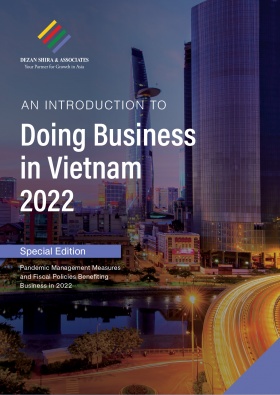Q&A: The RCEP Advantage – New Trade Opportunities in Vietnam
Officially in force since the beginning of this year, the world’s largest trade bloc in history, the Regional Comprehensive Economic Partnership (RCEP) further builds on free trade agreements within APAC and will push economic integration and shape future trade policy. Member economies range from powerhouses such as China, Japan, and Australia to smaller markets like Brunei, Cambodia, and Laos. Joining the RCEP will help all of them reduce trade barriers and improve market access for their goods. However, who will benefit from the RCEP the most? Will there be any victims of free trade?
Will Vietnam be overwhelmed with a free flow of goods its manufacturing sector cannot compete with? Or will see an ever-increasing influx of FDI towards the country, tapping the newly gained access, creating jobs, and boosting its economy?
Recently Marco Förster, Manager, International Business Advisory and Dang Trinh, Associate, International Business Advisory, Dezan Shira & Associates, provided an overview of the RCEP, its brief history, and future developments, as well as concrete benefits it will provide for Vietnam and foreign investors in the market. The full webinar can be viewed here. We have shared a few highlights below.
What is the RCEP?
The Regional Comprehensive Economic Partnership (RCEP) is an agreement between ASEAN member countries and its free trade agreement (FTA) members. The agreement includes Brunei, Cambodia, Indonesia, Laos, Malaysia, Myanmar, the Philippines, Singapore, Thailand, Vietnam, China, Japan, South Korea, and Australia. The RCEP is a mix of high-, middle- and low-income countries. It is important to note that ASEAN was the initiator of this partnership.
The objective of the RCEP is to eliminate close to 90 percent of tariffs within 20 years. The aim is to also reduce tariffs and red tape with unified rules of origin facilitating international supply chains with trade within the region. One of the drawbacks that has been highlighted is the absence of a focus on labor unions, environment protection, or government subsidies compared to more established FTAs such as the CPTPP and the EVFTA. There are no unified standards on labor and the environment.
Nevertheless, the RCEP is an important agreement as it represents about 30 percent of the world’s population and 30 percent of global GDP making it the largest trade bloc in history.
Can you tell us the impact of the RCEP on Vietnam?
The RCEP is Vietnam’s most recent trade agreement and will allow for more development and trade in the form of integrated markets for Vietnamese goods. Vietnam was already well integrated in the region; therefore most benefits will not come from tariff reductions alone but from other elements such as trade facilitation measures like unified rules of origin.
The tariff eliminations are planned for a period of 15 years. For example, Vietnam has imposed high tariffs on motor parts, non-metallic minerals, and animal products among others. However, with the RCEP, tariffs on such products will be reduced by 2035 significantly.
What are some benefits that we can expect in Vietnam?
The RCEP brings further development and trade opportunities for Vietnam. This includes an integrated market for Vietnamese goods and the elimination of tariffs in certain sectors. For example, regarding tariffs faced by Vietnam, the sectors with the highest reductions are food and beverage, petroleum, coal products, and meat.
With an integrated market, the simplification of customs procedures and common rules of origin makes it easier for businesses to trade within the region. Common rules of origin are particularly helpful as businesses can manufacture their products while obtaining raw materials from RCEP members and sell to RCEP members with reduced tariffs and costs.
The RCEP also allows Vietnamese products to enter high-end markets such as Australia, New Zealand, and Japan. Previously, Vietnamese products have not been able to be verified for market access to these high-end markets.
In addition, the RCEP solidifies Vietnam as a manufacturing hub in Asia. Vietnam is a market-driven export-oriented model. The agreement helps Vietnam become more attractive as an investment destination particularly from within the region due to the RCEP.
Which industries are expected to benefit the most in Vietnam due to the RCEP?
As the RCEP is focused on trade facilitation, the blue-collar sector is expected to benefit the most. In addition, consumer sectors like tourism, education, entertainment, healthcare, and retail are also expected to benefit as the middle class expands. Further, Vietnam’s export-oriented industries such as IT, agriculture, automobiles, footwear, and telecommunications are expected to see gains.
What are some challenges posed by the agreement?
The RCEP will pose a higher level of competition for Vietnam. This will not only be in manufacturing but also in services due to the decreased level of protection of goods traded within the bloc. However, local businesses in Vietnam may also face challenges in keeping clients if they are not able to adapt and meet RCEP requirements.
As mentioned earlier, the RCEP does not include provisions on environment, labor, or intellectual property and thus falls short of such commitments.
About Us
Vietnam Briefing is produced by Dezan Shira & Associates. The firm assists foreign investors throughout Asia from offices across the world, including in Hanoi, Ho Chi Minh City, and Da Nang. Readers may write to vietnam@dezshira.com for more support on doing business in Vietnam.
We also maintain offices or have alliance partners assisting foreign investors in Indonesia, India, Singapore, The Philippines, Malaysia, Thailand, Italy, Germany, and the United States, in addition to practices in Bangladesh and Russia.
- Previous Article Why Vietnam is Increasingly Focusing on Digital Accounting
- Next Article Vietnam’s Economy in Q1 Expands, but Supply Chain, Inflation Pose Challenges







